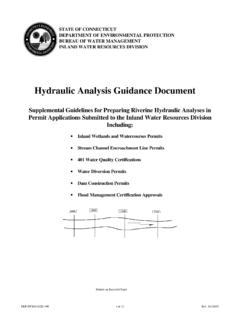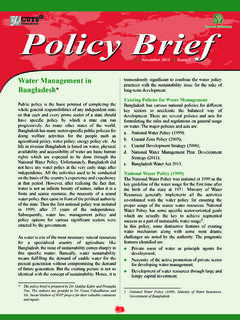Transcription of After the Flood: Protecting Your Drinking Water
1 After the flood : Protecting your Drinking Water IDAHO As is common throughout the year, some parts of Idaho experience severe flooding as a DEPARTMENT OF result of spring rains, heavy thunderstorms, rapid winter snow thaws, or from the impact of ENVIRONMENTAL. QUALITY wildfires in the state's watersheds. 1410 North Hilton Boise, ID 83706 Drinking Water quality can be compromised during extensive flooding. Regardless of 208/373-0502. whether you have your own Water supply, get Water from a public Water system, or operate a public Water utility, you might have to take special steps to ensure that your Drinking Water is safe if your well, public Water system, or Water treatment plant has been flooded. General guidelines are listed below. Private Wells People with private Drinking Water wells in flooded areas should assume that their Water is contaminated. Even though your well may not have undergone severe flooding, you cannot take it for granted that your Water is safe.
2 Under flood conditions, contaminated surface Water may enter directly into your underground source of Water via shallow gravel aquifers, a nearby well, an old improperly abandoned well, or some other nearby excavation bypassing the natural filtering process. After flood waters recede, check the well to see if any of the following conditions exist: was the well actually flooded? is the well in close proximity to flooded areas? has there been a change in Water quality ( , odor, color, taste)? If your particular situation meets any of the above criteria and you think that your Drinking Water is of questionable quality, take the following steps: Stop using the well Water for human consumption. Use only bottled or boiled Water as an alternative source for Drinking , cooking, and washing (see Emergency Disinfection below). Have the well Water tested for coliform bacteria. If tests show contamination, then you should disinfect the well. Disinfecting a Private Well If you suspect that your private well may be contaminated, or lab tests show the presence of coliform bacteria, contact your local DEQ office or health district for specific advice.
3 Disinfecting a well can sometimes be done by the well owner; however, for some wells it can be difficult to get the disinfectant into the well or other parts of the system that need disinfecting. DEQ recommends hiring a professional to disinfect your well. Professionals include licensed plumbers, pump installers, licensed Water system operators, or well drillers. 1. If professional help is not available, DEQ's Disinfecting Domestic Water Wells and Storage Tanks offers a detailed checklist for disinfecting a well. Before disinfecting a well After a flood, it is always important to check with a licensed electrician to ensure there is not an electrical hazard associated with the pump and electrical controls. Emergency Disinfection of Drinking Water for Small Amounts of Water If your well tested positive for coliform bacteria or being disinfected, and you need small amounts of Water for Drinking or cooking, then you can disinfect small amounts of Water using one of the three methods presented below.
4 You can treat your tap Water by either boiling it (the safest method of purifying Water ) or disinfecting with unscented household bleach or commercial disinfection tablets. Before purifying the Water , let any suspended particles settle to the bottom, or strain them through layers of paper towel or clean cloth. Option 1: Boiling. Boiling Water , when practical, is the preferred method to kill harmful bacteria and parasites. Vigorous boiling for one minute will kill any disease- causing microorganisms present in Water (at altitudes above one mile, boil for three minutes). Caution: If your well Water contains high nitrate concentrations (> 10 mg/L) or you suspect nitrate is present, then it is not safe for young children and women who are pregnant to drink the boiled well Water . Alternative sources of Water , such as bottled Water , should be used for cooking, Drinking , and for the preparation of infant formula for children six months of age and younger. In infants, high nitrate levels can interfere with the oxygen-carrying capacity of the child's blood leading to serious illness, in which health deteriorates rapidly over a period of days.
5 Symptoms of this acute condition include shortness of breath and blueness of the skin. Nitrate in groundwater originates primarily from excessive use of nitrogen fertilizers or from septic systems. Option 2: Using Liquid Bleach. If boiling Water is not an option, you can treat Water , intended for Drinking or cooking, by using unscented household chlorine bleach to kill microorganisms. Use only regular household liquid bleach that contains percent sodium hypochlorite. Do not use scented bleaches, colorsafe bleaches, or bleaches with added cleaners. If the Water is clear, add 8 drops (1/8 teaspoon) of liquid bleach per gallon (16 cups) of Water , stir and let stand for 30 minutes. However, if the Water is cloudy, add 16. drops (1/4 teaspoon) to a gallon. The disinfected Water should have a slight chlorine smell. If it does not, repeat the dosage and let stand for another 15 minutes before using. Be sure to use sanitized food grade containers for storing Water . This method is not guaranteed to be effective against certain parasites, such as cryptosporidium.
6 2. Option 3: Chlorine or Iodine Tablets. Chlorine tablets or iodine tablets containing the necessary dosage for Drinking Water disinfection can be purchased in a commercially prepared form. These tablets are available from drug and sporting goods stores and should be used as stated in the instructions. When instructions are not available, use one tablet for each quart of Water to be purified. Note: The above measures will kill most microbes but will not remove other contaminants such as heavy metals, salts, and most other chemicals. If you suspect the Water is unsafe because of chemicals, oils, poisonous substances, sewage, etc., do not use the Water for Drinking . Septic Systems and Flooding If flooding has occurred, homes may have a damaged or failing onsite sewage system. The system should be checked because After heavy rainfall or flooding, the wastewater leaving the septic tank may not be able to seep into the soil because the soil is already saturated. In such a situation, when the saturated soil cannot act as final filter, the unfiltered sewage material can enter into the groundwater aquifer and your Drinking Water supply.
7 It may take several days for the saturated soils to drain and allow your system to return to normal. If you suspect damage to your septic tank or have general questions, you should contact your local district health department. It may be necessary to have your system professionally inspected and serviced. Do not use your septic system if flood Water is standing on the drainfield. Be careful not to compact the drainfield area by driving or operating equipment in the area because compaction reduces the capacity of your drainfield to treat wastewater and could lead to an early failure of your entire system. Note. If you disinfect your own well, do not dump the spent chlorine solution (used in the disinfection) into your private septic system because it will kill bacteria essential for the proper operation of your septic tank and field. Flush onto a gravel drive or road. Advice for Customers of Public Water Systems If you are on a public Water system, your Water utility, local DEQ regional office, or local district health department will notify you of any unsafe Drinking Water conditions in the system and provide directions on what you can do to prevent exposure.
8 Notification can take place by radio, TV, newspapers or in some cases, by the use of door hangers, or door-to-door contacts, or signs posted in affected areas. If it becomes necessary to boil your Drinking Water , the owner or operator of the public Water system will notify you with instructions on how long to boil the Water and any other precautions you should take. If not notified by your Water utility, check with the company to see what the status is or what actions you may need to take. Customers of public Water systems do not need to test their Water . The operator of the public Water system will conduct these tests. If your home or any part of your property over the Water lines was flooded, or if you experience a reduction or loss of pressure in your home, it may be a wise precaution to hire a professional to flush your lines and drain and refill your Water 3. heater. Flushing should remove any air or contaminants that may have entered your plumbing system when the service was interrupted.
9 Ask your Water supplier about whether or not this may be necessary. Checklist for Operators of Public Water Systems (PWS). When flooding occurs or there is a loss of pressure, or some other type of system damage resulting in potential bacterial compromise, the owners of the public Water system should issue a boil Water notice until further testing can be conducted and the situation normalizes. If necessary, a boil Water advisory must be announced as soon as possible, even in advance of being notified by the regional DEQ office or district health department. If, as an operator, your Drinking Water distribution system was damaged or lost operating pressure, be sure to follow these steps: 1. Notify your customers immediately to boil Water for cooking, Drinking , or making ice. A public notification boil Water template and boil Water door hangers are available from your regional DEQ or district health department or on the DEQ website. (The template is also available in Spanish.)
10 2. Notify your regional DEQ office or local district health department that serves your area or county as soon as possible, at least within 24 hours. 3. Take samples as needed to ensure that clean Water is available in all parts of your system, and have the Water samples analyzed. 4. Take measures to flush your distribution system, disinfect it, and ensure its integrity. 5. If laboratory results show an acute E-coli/fecal MCL violation, send the Public Drinking Water System E-coli/fecal MCL Violation Reporting Form, and accompanying information electronically to your local regional DEQ office or district health department within 24-48 hours of an E-coli/fecal MCL received from the laboratory. 6. Once you have confirmed that your distribution system is capable of producing a stable supply of clean Water , you may lift the boil- Water advisory. If you have other questions, contact either your local district health department, DEQ. regional office, or the Drinking Water Program in the State Office (208-373-0409) for advice.





